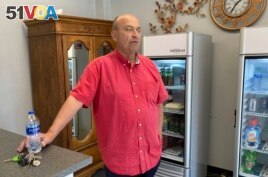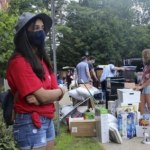19 September 2021
Businesses in the central parts of cities are losing huge profits as a result of the pandemic.
With offices nearby, the businesses used to be filled with workers seeking breakfast, lunch and everyday goods and gifts.
With offices still closed and workers remaining at home, some businesses are adapting to the changed market.
Surviving businesses have taken steps like doing more online sales, changing hours, cutting back workers, or selling new things.
Business owners had looked forward to the return of nearby workers this month as offices reopened. But, as COVID-19 cases rise again, many offices have delayed plans to bring workers back. Now, downtown businesses in the U.S. and overseas wonder if the changes may become permanent.
In the American city of Detroit, Michigan, Mike Frank's dry cleaning business was running out of money.
Frank started Clifford Street Cleaners eight years ago. Before the pandemic, monthly revenue was about $11,000. But by December 2020, it had dropped to $1,800, he said.
Frank had to borrow money from his wife to pay the bills. "I was almost ready to go out of business."
Instead of closing, Frank adapted. He changed part of his store into a small market. Now, he sells all kinds of cleaning products, bottled water, soft drinks and other goods. He also added a delivery service.

Mike Frank, owner of Clifford Street Cleaners, at his business in Detroit, September 2, 2021. (AP Photo/Mike Householder)
Finally, some foot traffic returned. With the combination of product sales and dry cleaning, revenue is back up to about $4,100 each month, he said. That is enough to keep the business open. And, he noted, the revenue is increasing each month.
In New York City's Lower Manhattan area, 224 businesses closed their doors in 2020 and 2021. That information is from the Alliance for Downtown New York. It says about 100 businesses have opened.
Jessica Lappin is president of the organization. "There's no question, it's hard" for business areas, she explained to the Associated Press. "We miss our workers."
Lappin predicts office workers will come back. But it might be two or three days a week, on different days or at different hours.
A block from New York's financial neighborhood, workers would wait in long lines to buy one of the healthy meals from Blue Park Kitchen.
"Things are completely different," owner Kelly Fitzpatrick said.
Online orders now make up 65 percent of the business. Those sales are less profitable, however, because Fitzpatrick has to give a percentage to the app company she uses for online orders. In all, the Blue Park has let nine of its workers go.
Nearby, Aankit Malhotra and his brother took over Benares, an Indian restaurant, in 2019. Most of their customers were bankers. When the pandemic hit, those customers disappeared. No one came in for the $13 lunch special the restaurant was known for. In the past, lunch sales represented 95 percent of the restaurant's business.
Now, Benares has about 10 lunch orders a day, down from 100.
But, also now, business is back to around 70 percent of levels before the pandemic. The brothers established a delivery service and began offering nighttime meals. The customers are now mostly younger people and families who live in the area.
"It's nice to see not just corporate people downtown," said Malhotra.
Jorge Guzman is an assistant professor of business at New York's Columbia University. He said the move of economic activity away from downtowns will likely continue. But there are new businesses opening in non-downtown areas.
"Downtowns are not going to die, exactly," Guzman said. "But it's going to be a little bit more of a mix, more residential and mixed-use" businesses.
In the British capital of London, office workers have been slowly returning. The government lifted COVID-19 restrictions on July 19, as the number of new infections began to drop. Recently, however, cases have been climbing again.
The number of downtown workers is far lower than before COVID.
"It was good, it was busy before the pandemic," said Rado Asatrian. He has worked as a haircutter at a beauty shop in the financial area for six years. Before COVID-19, he usually had 10 to 15 customers a day. Now, he sees three or four a day.
Asatrian said he might move to a busier area, change professions or move overseas.
In some downtowns, tourists are visiting again, helping businesses stay open.
In the U.S. city of Atlanta, Georgia, Kwan's Deli and Korean Food has almost as much summer business as it did before the pandemic.
During the worst part of the pandemic, Kwan's had lost about 80 percent of its business. But the situation is improving, thanks to travelers and events happening nearby.
Still, the coronavirus is causing a lot of unknowns about the autumn. Kwan's owner, Andrew Song, said he heard that some businesses have moved permanently or downsized.
"It's sort of hard to imagine what it will look like," he said, with office workers not returning.
I'm Caty Weaver. And I'm Alice Bryant.
The Associated Press reported this story. Alice Bryant adapted it for Learning English. Caty Weaver was the editor.
_
Words in This Story
adapt -v. to change (something) so that it operates better or is better fitted to a purpose
revenue -n. money that is made by or paid to a business or an organization
customer -n. someone who buys goods or services from a business
delivery -n. the act of taking something to a person or place
residential -adj. of or relating to the places where people live












